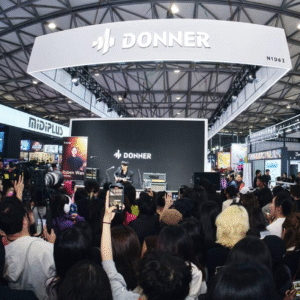
We only recommend products that we use and believe in. When you purchase through links on our site, we may earn an affiliate commission.
Joel Shearer has enjoyed a multi-decade, and multi-dimensional, career as a solo artist and go-to session musician
Starting out in the ’90s, he worked with the likes of Sarah McLachlan, Damien Rice and played guitar on Alanis Morrisette’s Grammy Award winning Jagged Little Pill. Over the last decade, Shearer’s work has taken a decisive turn towards the experimental, and now he is perhaps better known for creating ambient soundscapes for films, art installations and his own solo projects.
“My focus all across the board has been very singular: to put as much beauty into the world that I possibly can,” Shearer says. “It is the same thing with any of my other projects — anything I am releasing in the instrumental ambient world is really focused on trying to create spaces for people to feel better.”

Creating a new universe of sound with COSMOS
Recently, Shearer began ‘collaborating’ with SOMA Laboratory’s COSMOS Drifting Memory Station: a sonic morphing machine capable of evolving and shapeshifting a myriad of sounds that lead to unexpected and inspirational musical outcomes. In addition to live performances, he’s been working with COSMOS in a recording studio setting, creating mini-documentary film soundtracks as well as releases under his own name.
So far, COSMOS has been the perfect companion to Shearer’s instrumental ambient music: “I feel like Cosmos is more than just a pedal — it’s like having another artist in the room with you,” he says. “What I love about it specifically is that, unlike other effects units, it is more of an instrument. But it has its own mind and when you feed it something, it takes it and run with it. There are these reciprocities happening.”
Shearer’s “Didly 1” was his very first experimental piece working with COSMOS, and started with a simple sound which then evolved: “This piece was created from one little sound on the synth, which I then let bounce around inside COSMOS, where it began swirling and drifting,” he says. “I don’t know what is going to happen when I put something into it, but I love managing the chaos and finding the beauty in that. In music composition, if everything is so controlled and perfect, things can get really mundane; COSMOS is the opposite of that,” says Shearer.
Shearer has been using COSMOS both in the studio and in live performance: “I did a gig with Cosmos the other night and it was just cruising,” he says. “I get a simple sound going, and then I push it off to the side and it starts doing its thing, constantly evolving. I can play alongside this, feed it something more and play alongside it some more. It truly feels like I am playing with another person.”
He says that in the studio, he has a unit hard wired into his effects send and return: “I keep a COSMOS wired in the same way you might have an echoplex, a plate reverb or a Roland tape echo,” he says. “My COSMOS just has to be there as a studio effect that can always be patched in because you can put anything through it; a vocal, a guitar, or any other instrument. Also, it has its own unique sound. If you are ever stuck creatively either in performance or even in a mix, just run something through COSMOS — it will do something unexpected and doesn’t need anything else. It just has to be patched in.”
Much more than a looper
Cosmos is built with four different algorithms, which process at 32-bit/48kHz. There are two or four delay lines, which can morph in relation to one another. Additionally, the reverb in Cosmos is very uncommon and due to its enormous buffer size, can simulate the echo of a hall several kilometers in size. As a result of this, early reflections sound like individual echoes, which merge very slowly into the finely dispersed noise intrinsic of a reverb. Cosmos has several different firmware versions that are available to users for free here — the latest firmware adds no less than 9 new algorithms.
Each of the (5) foot switches on Cosmos provides access to the most important functions, and crossfading between on and off states facilitates ultra-smooth transitions. The Record footswitch enables quick and spontaneous recording of a new signal into the buffer. For further sonic shaping, Cosmos contains a high and low pass filter each containing three cutoff frequencies, and a Reverse switch enables seamless reversal of an incoming audio signal.
Erase switch allows the user to eliminate certain parts of a loop, or erase the entire buffer if required.
With its Blur, Drift, Drive and Suppressor/Compressor knobs, the user has an entire range of sonic shaping facilities that can blur and smear a sound source or produce intermodulation and panning effects. With Drive and Suppressor/Compressor, a range of distortion and limiting / auto-leveling possibilities expand user control even further — the only limitation is your own imagination.
To learn more about Joel Shearer, please visit www.joelshearer.com, or visit his Bandcamp page at https://joelshearer.bandcamp.com. To learn more about COSMOS, please visit https://somasynths.com/cosmos or visit an authorized SOMA Laboratory dealer.



